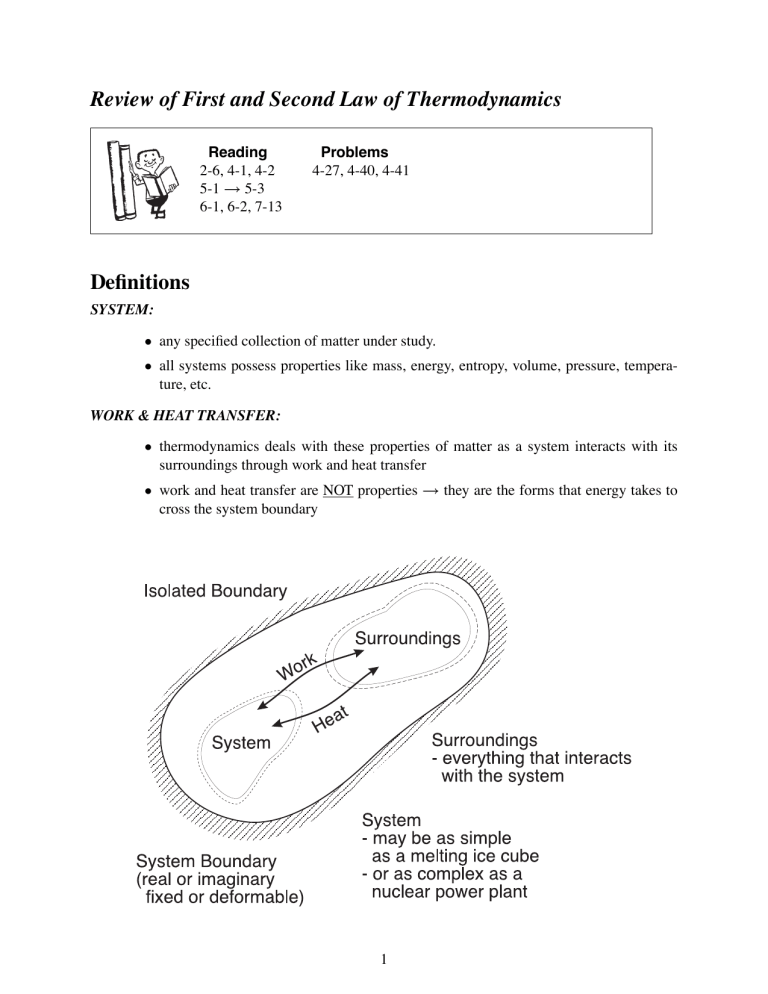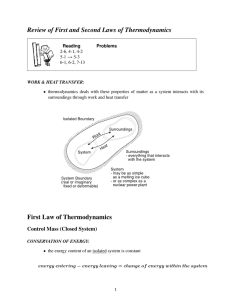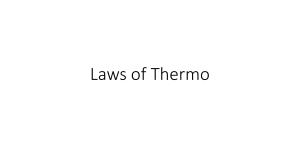
Review of First and Second Law of Thermodynamics Reading 2-6, 4-1, 4-2 5-1 → 5-3 6-1, 6-2, 7-13 Problems 4-27, 4-40, 4-41 Definitions SYSTEM: • any specified collection of matter under study. • all systems possess properties like mass, energy, entropy, volume, pressure, temperature, etc. WORK & HEAT TRANSFER: • thermodynamics deals with these properties of matter as a system interacts with its surroundings through work and heat transfer • work and heat transfer are NOT properties → they are the forms that energy takes to cross the system boundary 1 First Law of Thermodynamics Control Mass (Closed System) CONSERVATION OF ENERGY: • the energy content of an isolated system is constant energy entering − energy leaving = change of energy within the system Example: A Gas Compressor Performing a 1st law energy balance: ⎧ ⎪ ⎨ ⎫ Initial ⎪ ⎬ + Energy ⎪ ⎪ ⎩ ⎭ − E1 Energy gain W1−2 Energy loss Q1−2 ⎧ ⎪ ⎨ E1 + W1−2 − Q1−2 = E2 2 ⎫ F inal ⎪ ⎬ = ⎪ Energy ⎪ ⎩ ⎭ E2 Control Volume Analysis (Open System) CONSERVATION OF MASS: ⎧ ⎪ ⎨ rate of increase of mass within ⎪ ⎩ the CV d dt ⎫ ⎪ ⎬ ⎧ ⎪ ⎨ net rate of = ⎪ mass f low ⎪ ⎭ ⎩ IN (mCV ) = ṁIN − ṁOUT where: mCV = V ρ dV ṁIN = (ρ v ∗ A)IN ṁOUT = (ρ v ∗ A)OUT with v ∗ = average velocity 3 ⎫ ⎪ ⎬ ⎧ ⎪ ⎨ net rate of − ⎪ mass f low ⎪ ⎭ ⎩ OU T ⎫ ⎪ ⎬ ⎪ ⎭ CONSERVATION OF ENERGY: The 1st law states: ECV (t) + ΔQ + ΔWshaf t + (ΔEIN − ΔEOUT )+ (ΔWIN − ΔWOUT ) = ECV (t + Δt) where: ΔEIN = eIN ΔmIN ΔEOUT = eOUT ΔmOUT ΔW = flow work e = E m = u + internal (v ∗ )2 2 kinetic 4 + gz potential (1) Second Law of Thermodynamics Fundamentals 1. Like mass and energy, every system has entropy. Entropy is a measure of the degree of microscopic disorder and represents our uncertainty about the microscopic state. 2. Unlike mass and energy, entropy can be produced but it can never be destroyed. That is, the entropy of a system plus its surroundings (i.e. an isolated system) can never decrease (2nd law). Pm = m2 − m1 = 0 (conservation of mass) PE = E2 − E1 = 0 (conservation of energy) → 1st law PS = S2 − S1 ≥ 0 → 2nd law The second law states: (ΔS)system + (ΔS)surr. ≥ 0 where Δ ≡ f inal − initial Example: A freezing process 5 3. Reference: In a prefect crystal of a pure substance at T = 0 K, the molecules are completely motionless and are stacked precisely in accordance with the crystal structure. Since entropy is a measure of microscopic disorder, then in this case S = 0. That is, there is no uncertainty about the microscopic state. 4. Relationship to Work: For a given system, an increase in the microscopic disorder (that is an increase in entropy) results in a loss of ability to do useful work. 5. Heat: Energy transfer as heat takes place as work at the microscopic level but in a random, disorganized way. This type of energy transfer carries with it some chaos and thus results in entropy flow in or out of the system. 6. Work: Energy transfer by work is microscopically organized and therefore entropy-free. Example: Slow adiabatic compression of a gas A process 1 → 2 is said to be reversible if the reverse process 2 → 1 restores the system to its original state without leaving any change in either the system or its surroundings. → idealization where S2 = S1 ⇒ PS = 0 T2 > T1 ⇒ increased microscopic disorder V2 < V1 ⇒ reduced uncertainty about the whereabouts of molecules Reversible + Adiabatic P rocess ⇒ Isentropic P rocess PS =0 Q=0 S1 =S2 The 2nd law states: PS = (ΔS)system + (ΔS)surr ≥ 0 6 where: >0 irreversible (real world) =0 reversible (frictionless, perfectly elastic, inviscid fluid) But does: Isentropic P rocess ⇒ Reversible + Adiabatic NOT ALWAYS - the entropy increase of a substance during a process as a result of irreversibilities may be offset by a decrease in entropy as a result of heat losses. General Derivation of Gibb’s Equation From a 1st law energy balance when KE and PE are neglected Energy Input = Energy Output + Increase in Energy Storage dQ = dW + dU (1) dif f erential amount We know that the differential form of entropy is dS = dQ (2) T dW = P dV Combining Eqs. 1, 2 and 3 dS = dU T + P dV T ⇒ ds = du + P dv T T per unit mass 7 (3) Second Law Analysis for a Control Mass • control mass is uniformly at TT ER at all times • control mass has a fixed size (V = constant) From Gibb’s equation 0 TT ER dS = dU + P dV From the 1st law dU = dQ Therefore for a reversible process dS = dQ TT ER We integrate to give S2 − S1 = Q1−2 TT ER and for a non-reversible process dS = dQ TT ER + dPS We integrate to give S2 − S1 = Q1−2 TT ER + PS1−2 8 Second Law Analysis for a Control Volume where: FR - fluid reservoir TER - thermal energy reservoir MER - mechanical energy reservoir 9 For the isolated system (ΔS)sys + (ΔS)sur = PS1−2 ≥ 0 B ΔSCV − sA mA 1−2 + sB m1−2 − QA 1−2 TTAER + QB 1−2 TTBER = PS1−2 or as a rate equation dS dt ⎛ = ⎝sṁ + CV Q̇ TT ER ⎞ ⎛ ⎠ − ⎝sṁ + IN Q̇ TT ER This can be thought of as accumulation = IN − OU T + generation 10 ⎞ ⎠ + ṖS OUT






